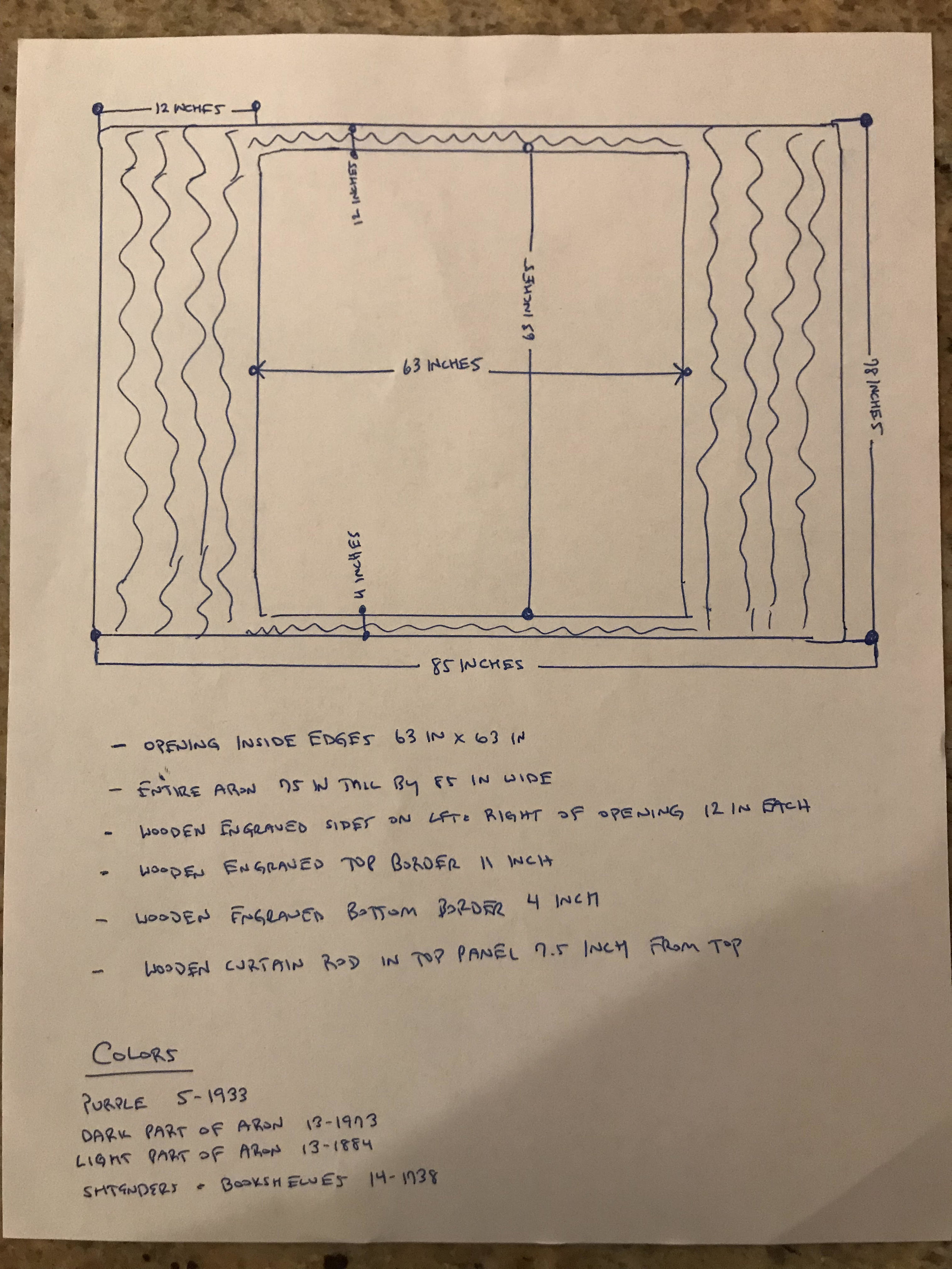A Yeshiva’s Burning Love of Torah
BRINGING THE ROOM TOGETHER
About a day after Mishpacha Magazine featured a 10-page cover article on my parochets, Mr. Josh K. of Memphis, Tennessee wrote me an enthusiastic e-mail.
When we first spoke on the phone, he explained that he had been davenning for over a year to find just the perfect person to create a parochet for the Feinstone Yeshiva of the South. And he was sure that I was his answer.
With that decisive introduction, he went on to e-mail me photos of the yeshiva’s Beis Medrash. It was immediately apparent that differing styles and design elements were vying for center stage. Josh was adamant that the new parochet would serve to ‘bring the room together’.
Let’s pause for a moment and analyze the Beis Medresh very simply. Do you see what I see?
- brick walls
- black LED windows featuring bluish psukim
- skylights
- modern bima, amud and Aron Kodesh by Jeremy Kimchi
- beige sefarim shelves
- black chairs
To add more flavor to the challenge, Josh mentioned that this Beis Medresh was used by the kindergarten boys, all the way up to the yeshiva bochurs and kollel yungeleit.
In short, this parochet would serve to not only ‘bring the room together’- it would essentially unite the Yeshiva’s entire student body.
“What sort of message should a yeshiva’s parochet give over?”, I pondered during the ensuing days.
Thankfully, Hashem directed me straight to Rav Shlomo Wolbe’s sefer “Planting and Building in Chinuch”, where I discovered the answer.
Here are Rav Wolbe’s holy words:
DUAL PROCESSES IN DIVINE GUIDANCE
Two complementary processes lie beneath all progress and development in the world, and the better we understand them, the better we will be at encouraging and shaping the development of our children and students.
We see references to these complementary processes in the Shemoneh Esrei. There we find two blessings that relate to the geulah: "Blessed are You, Hashem, Who builds Yerushalayim" and "Blessed are You, Hashem, Who causes salvation to sprout." The first blessing refers to the construction of Yerushalayim, and the second refers to growth towards Mashiach.
Growth is a natural, organic process. Seeds placed into the soil will sprout on their own. So will trees and flowers. In contrast, construction is a manual process....
PLANTING AND BUILDING IN CHINUCH
In this same way we should understand the idea of sprouting and construction in childhood education (and in the process of education ourselves!) If we want the child to grow into a Jew who learns Torah and fulfills mitzvos, we must plant in him the seeds of Torah. ....
About construction in chinuch, we find the following in Pirkei Avos (5:21): "At five years of age, the child should learn Tanach; at ten, Mishnah; and at fifteen, Gemara." Here Chazal teach us that there are levels in the process of building a man into a talmid chacham, and the chinuch at each of these levels must match the child's natural development. ...
If we allow a child to sprout and grow without building him, the result is a wild man. If we build a child without relating to his koach ha-tzemichah, we turn him into a robot. Chinuch consists of both the koach ha-tzemichah and the action of building. That is, we must build a child while cultivating his spiritual potentials."
THE DEEPER MEANING OF THE PAROCHET SKETCH
After internalizing Rav Wolbe’s message, the preliminary parochet sketch can be immediately understood:
Front and center are the holy words "Ahava Rabba Ahavtanu", the precursor to the four windows in the Beis Medresh. The font is very similar and will bring together the "Ahava Rabba" theme in the windows.
Behind those words, embroidered in autumn tones with a Swarovski-laden border, is an open sefer, which symbolizes learning. This somewhat abstract open sefer brings together the two asymmetrical Torahs engraved by Kimchi on either side of the Aron Kodesh. The sefer is also the symbol of the Yeshiva, being the goal of the 12+ years of chinuch that the boys receive in the institution.
The background is comprised of black, chocolate and navy appliques forming fluid lines all around the parochet. "Bricks" formed out of clusters of square and rectangular Swarovskis emanate from the Sefer towards the top of the Aron Kodesh.
The fluid lines refer to the "planting in Chinuch", while the Swarovski bricks refer to the "building in Chinuch".
The fluid lines also flow seamlessly with Kimchi's fluid engravings, and the crystal "bricks" mirror the interesting cream-colored brick walls of the Beit Midrash.
Josh was elated with this deeply meaningful parochet design and even requested adding the first paragraph of the Shema prayer in the parochet’s beige inner border.
Here is the final sketch:
THREADS
Once the design was confirmed, I moved on to sourcing the threads, Swarovskis and applique fabrics.
Within days, Josh received a thread color chart from Madeira USA- the same color chart I use in Israel. Going down to the yeshiva with an interior designer, Josh matched all the main colors in the Beis Medresh and sent me the list. Thus I was able to purchase exactly the right color threads and materials to coordinate perfectly with the Aron Kodesh, walls, amud and passuk windows.
MATERIALS
Materials: I decided to combine shiny senjan materials with heavy plush upholstery materials to create an unusual and eye-catching combination.
The colors are alive! You’ll notice saturated, fiery shades of brown, orange, gold, red and apricot contrasting with turquoise and purple. I really want this parochet to pop!
800 hand-applied Swarovskis in a variety of cuts, hues and sizes flow out of the ‘Alef’ of Ahava to create a mesmerizing wave of loving ‘shtaygen’ that will keep the bachurim excited for years to come!















